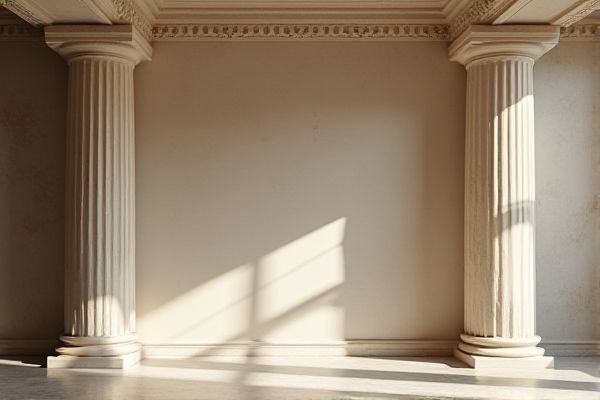
Structural columns bear the load of a building, providing essential support to maintain its integrity, while decorative columns primarily serve aesthetic purposes without bearing significant weight. To understand the differences and choose the right type for Your project, continue reading this article.
Table of Comparison
| Feature | Structural Column | Decorative Column |
|---|---|---|
| Purpose | Supports loads and structural integrity | Enhances aesthetics without load support |
| Material | Concrete, steel, wood, masonry | Plaster, fiberglass, faux wood, lightweight materials |
| Load-bearing | Yes, critical for stability | No, purely ornamental |
| Design | Functional and engineering-driven | Varied styles: classical, modern, custom |
| Cost | Higher due to structural requirements | Generally lower, depends on design complexity |
| Installation | Requires engineering and permits | Simple, often decorative add-ons |
| Examples | Building supports, bridge columns | Porch pillars, interior decor columns |
Introduction to Structural and Decorative Columns
Structural columns are essential load-bearing elements designed to support the weight of a building and ensure its stability, typically made from materials like steel, concrete, or reinforced wood. Decorative columns primarily serve aesthetic purposes, enhancing the architectural design without bearing significant structural loads, often crafted from plaster, fiberglass, or lightweight composites. Your choice between structural and decorative columns depends on whether the priority is functionality and safety or visual appeal and design enhancement.
Defining Structural Columns
Structural columns are essential load-bearing elements in construction that support the weight of buildings, transferring loads from roofs and upper floors down to the foundation. Unlike decorative columns, which serve primarily aesthetic purposes, structural columns are engineered for strength, stability, and safety, often made from materials like reinforced concrete, steel, or timber. Understanding the role of structural columns helps you distinguish them from purely ornamental features and ensures the integrity of your architectural design.
Defining Decorative Columns
Decorative columns serve primarily aesthetic purposes, enhancing architectural style without bearing structural loads, contrasting with structural columns designed to support weight and ensure building stability. These ornamental columns often replicate classical orders, featuring intricate designs and materials chosen for visual appeal rather than strength. Their integration emphasizes design and ambiance, making them key elements in both interior and exterior architecture where structural support is provided by hidden frameworks.
Key Differences Between Structural and Decorative Columns
Structural columns are essential load-bearing elements designed to support the weight of a building's structure, typically made from reinforced concrete, steel, or timber to ensure stability and safety. Decorative columns primarily serve an aesthetic purpose, enhancing architectural design without bearing significant structural loads, often crafted from lightweight materials like plaster or fiberglass. The key difference lies in their function: structural columns provide critical support and strength, while decorative columns focus on visual appeal and style.
Common Materials for Structural Columns
Structural columns are typically made from materials such as reinforced concrete, steel, and timber due to their strength and load-bearing capabilities. Reinforced concrete offers durability and fire resistance, while steel provides high tensile strength and flexibility in design. Your choice of material impacts the column's performance and the overall stability of the structure.
Typical Materials for Decorative Columns
Typical materials for decorative columns include fiberglass, polyurethane, and plaster, chosen for their lightweight properties and ease of installation. These materials allow intricate designs and finishes that mimic traditional stone, wood, or metal while being more cost-effective and resistant to weathering. Unlike structural columns, which prioritize strength using steel or reinforced concrete, decorative columns focus on aesthetic appeal without bearing loads.
Architectural Roles in Building Design
Structural columns serve as primary load-bearing elements, supporting the vertical weight of a building and transferring forces to the foundation, ensuring stability and safety. Decorative columns function primarily to enhance aesthetic appeal, often replicating classical architectural styles without contributing to the building's structural integrity. In architectural design, balancing structural requirements with decorative elements allows for both functional support and visual sophistication in building facades and interiors.
Cost Comparison: Structural vs Decorative Columns
Structural columns typically cost more due to their load-bearing function, requiring durable materials like reinforced concrete or steel, and specialized engineering. Decorative columns are generally less expensive, made from lighter materials such as fiberglass or plaster, focusing on aesthetics rather than strength. Your choice impacts budget significantly, as structural columns involve higher installation costs and compliance with building codes compared to decorative options.
Maintenance and Longevity Considerations
Structural columns require regular inspections and maintenance to ensure their load-bearing capacity remains intact, often involving professional assessments for cracks, corrosion, or shifting. Decorative columns, primarily serving aesthetic purposes, generally demand less rigorous upkeep, focusing on surface cleaning and occasional touch-ups to preserve their appearance. Your choice between structural and decorative columns should factor in the long-term durability needs and maintenance efforts required for your building's safety and design integrity.
Choosing the Right Column Type for Your Project
Selecting the right column type involves understanding the primary purpose of your structure; structural columns provide essential load-bearing support, ensuring stability and safety, while decorative columns enhance aesthetics without contributing to the building's integrity. Your choice depends on whether strength and function or visual appeal and architectural style are the project's priorities. For projects requiring both, combining structural capabilities with decorative finishes offers an optimal balance.
 homyna.com
homyna.com